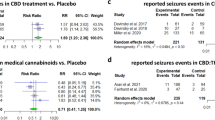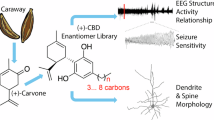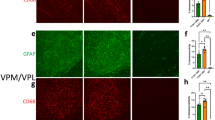Abstract
Epilepsy often presents with severe emotional comorbidities including anxiety and abnormal fear responses which impose a significant burden on, and reduce, quality of life in people living with the disease. Our lab has recently shown that kindled seizures lead to changes in emotional processing resulting from the downregulation of anandamide signalling within the amygdala. Phytocannabinoids derived from the Cannabis sativa plant have attracted a lot of interest as a new class of drugs with potential anticonvulsant effects. Among the wide number of compounds occurring in Cannabis sativa, Δ9- tetrahydrocannabinol (THC), the one responsible for its main psychoactive effects, and the nonpsychoactive cannabidiol (CBD) have been extensively examined under pre-clinical and clinical contexts to control seizures, however, neither have been assessed in the context of the management of emotional comorbidities associated with seizure activity. We used two behavioural procedures to assess anxiety- and fear-like responding in adult male Long-Evans rats: elevated plus maze and auditory fear conditioning. In agreement with previous reports, we found seizure-induced increases in anxiety- and fear-like responding. These effects were reversed by either CBD (vaporized) or THC (oral). We also found that antagonism of serotonin 1 A receptors prior to CBD exposure prevented its protective effects. Phytocannabinoids offer a novel and reliable opportunity to treat seizure induced comorbid emotional alterations.
This is a preview of subscription content, access via your institution
Access options
Subscribe to this journal
Receive 13 print issues and online access
$259.00 per year
only $19.92 per issue
Buy this article
- Purchase on SpringerLink
- Instant access to full article PDF
Prices may be subject to local taxes which are calculated during checkout





Similar content being viewed by others
References
Engel J. Introduction to temporal lobe epilepsy. Epilepsy Res. 1996;26:141–50.
Rho JM, White HS. Brief history of anti‐seizure drug development. Epilepsia Open. 2018;3:114–9.
Eddy CM, Rickards HE, Cavanna AE. The cognitive impact of antiepileptic drugs. Ther Adv Neurol Disord. 2011;4:385–407.
Bridgeman MB, Abazia DT. Medicinal Cannabis: History, Pharmacology, And Implications for the Acute Care Setting. P T. 2017;42:180–8.
Perucca E. Cannabinoids in the Treatment of Epilepsy: Hard Evidence at Last? J Epilepsy Res. 2017;7:61–76.
Zaheer S, Kumar D, Khan MT, Giyanwani PR, Kiran F. Epilepsy and Cannabis: A Literature Review. Cureus. 2018;10:e3278.
Bedse G, Colangeli R, Lavecchia AM, Romano A, Altieri F, Cifani C, et al. Role of the basolateral amygdala in mediating the effects of the fatty acid amide hydrolase inhibitor URB597 on HPA axis response to stress. Eur Neuropsychopharmacol. 2014;24:1511–23.
Morena M, Patel S, Bains JS, Hill MN. Neurobiological Interactions Between Stress and the Endocannabinoid System. Neuropsychopharmacology. 2016;41:80–102.
Hurd YL, Yoon M, Manini AF, Hernandez S, Olmedo R, Ostman M, et al. Early Phase in the Development of Cannabidiol as a Treatment for Addiction: Opioid Relapse Takes Initial Center Stage. Neurotherapeutics. 2015;12:807–15.
Rapin L, Gamaoun R, El Hage C, Arboleda MF, Prosk E. Cannabidiol use and effectiveness: real-world evidence from a Canadian medical cannabis clinic. J Cannabis Res. 2021;3:19.
Lee JLC, Bertoglio LJ, Guimarães FS, Stevenson CW. Cannabidiol regulation of emotion and emotional memory processing: relevance for treating anxiety-related and substance abuse disorders. Br J Pharmacol. 2017;174:3242–56.
Hasbi A, Madras BK, George SR. Endocannabinoid System and Exogenous Cannabinoids in Depression and Anxiety: A Review. Brain Sci. 2023;13:325.
Fogaça MV, Reis FMCV, Campos AC, Guimarães FS. Effects of intra-prelimbic prefrontal cortex injection of cannabidiol on anxiety-like behavior: involvement of 5HT1A receptors and previous stressful experience. Eur Neuropsychopharmacol. 2014;24:410–9.
Fagherazzi EV, Garcia VA, Maurmann N, Bervanger T, Halmenschlager LH, Busato SB, et al. Memory-rescuing effects of cannabidiol in an animal model of cognitive impairment relevant to neurodegenerative disorders. Psychopharmacol. 2012;219:1133–40.
Navarrete F, García-Gutiérrez MS, Gasparyan A, Austrich-Olivares A, Manzanares J. Role of Cannabidiol in the Therapeutic Intervention for Substance Use Disorders. Front Pharmacol. 2021;12:626010.
Cheng D, Spiro AS, Jenner AM, Garner B, Karl T. Long-term cannabidiol treatment prevents the development of social recognition memory deficits in Alzheimer’s disease transgenic mice. J Alzheimers Dis. 2014;42:1383–96.
Chen K, Ratzliff A, Hilgenberg L, Gulyás A, Freund TF, Smith M, et al. Long-term plasticity of endocannabinoid signaling induced by developmental febrile seizures. Neuron. 2003;39:599–611.
Romigi A, Bari M, Placidi F, Marciani MG, Malaponti M, Torelli F, et al. Cerebrospinal fluid levels of the endocannabinoid anandamide are reduced in patients with untreated newly diagnosed temporal lobe epilepsy. Epilepsia. 2010;51:768–72.
Colangeli R, Morena M, Pittman QJ, Hill MN, Teskey GC. Anandamide Signaling Augmentation Rescues Amygdala Synaptic Function and Comorbid Emotional Alterations in a Model of Epilepsy. J Neurosci. 2020;40:6068–81.
Colangeli, Morena R, Werner M, Thompson A, Stelt RJ, van der M, et al. 2-AG-Mediated Control of GABAergic Signaling Is Impaired in a Model of Epilepsy. J Neurosci. 2023;43:571–83.
Di Marzo V, Piscitelli F. The Endocannabinoid System and its Modulation by Phytocannabinoids. Neurotherapeutics. 2015;12:692–8.
Jacobson MR, Watts JJ, Boileau I, Tong J, Mizrahi R. A systematic review of phytocannabinoid exposure on the endocannabinoid system: Implications for psychosis. Eur Neuropsychopharmacol. 2019;29:330–48.
Maccarrone M. Phytocannabinoids and endocannabinoids: different in nature. Rend Fis Acc Lincei. 2020;31:931–8.
Busquets-Garcia A, Gomis-González M, Srivastava RK, Cutando L, Ortega-Alvaro A, Ruehle S, et al. Peripheral and central CB1 cannabinoid receptors control stress-induced impairment of memory consolidation. Proc Natl Acad Sci USA. 2016;113:9904–9.
Bedse G, Hartley ND, Neale E, Gaulden A, Patrick T, Kingsley P, et al. Functional Redundancy Between Canonical Endocannabinoid Signaling Systems in the Modulation of Anxiety. Biol Psychiatry. 2017;82:488–99.
Smirnov MS, Kiyatkin EA. Behavioral and temperature effects of delta 9-tetrahydrocannabinol in human-relevant doses in rats. Brain Res. 2008;1228:145–60.
Manwell LA, Ford B, Matthews BA, Heipel H, Mallet PE. A vapourized Δ(9)-tetrahydrocannabinol (Δ(9)-THC) delivery system part II: comparison of behavioural effects of pulmonary versus parenteral cannabinoid exposure in rodents. J Pharm Toxicol Methods. 2014;70:112–9.
Moore CF, Weerts EM. Cannabinoid tetrad effects of oral Δ9-tetrahydrocannabinol (THC) and cannabidiol (CBD) in male and female rats: sex, dose-effects and time course evaluations. Psychopharmacol. 2022;239:1397–408.
Cuttler C, Mischley LK, Sexton M. Sex Differences in Cannabis Use and Effects: A Cross-Sectional Survey of Cannabis Users. Cannabis Cannabinoid Res. 2016;1:166–75.
Baglot SL, Hume C, Petrie GN, Aukema RJ, Lightfoot SHM, Grace LM, et al. Pharmacokinetics and central accumulation of delta-9-tetrahydrocannabinol (THC) and its bioactive metabolites are influenced by route of administration and sex in rats. Sci Rep. 2021;11:23990.
Kim J, De Jesus O. Medication Routes of Administration. In: StatPearls. Treasure Island (FL): StatPearls Publishing; 2024.
Blair RDG. Temporal Lobe Epilepsy Semiology. Epilepsy Res Treat. 2012;2012:751510.
Racine RJ. Modification of seizure activity by electrical stimulation. II. Motor seizure. Electroencephalogr Clin Neurophysiol. 1972;32:281–94.
Hume C, Baglot SL, Javorcikova L, Melts V, Bieber JB, Hill MN. Characterising ‘the munchies’; effects of delta-9-tetrahydrocannabinol (THC) vapour inhalation on feeding patterns, satiety, and macronutrient-specific food preference in male and female rats. bioRxiv. https://doi.org/10.1101/2022.09.22.509090 2022.
Kruse LC, Cao JK, Viray K, Stella N, Clark JJ. Voluntary oral consumption of Δ9-tetrahydrocannabinol by adolescent rats impairs reward-predictive cue behaviors in adulthood. Neuropsychopharmacology. 2019;44:1406.
Kaster MP, Santos ARS, Rodrigues ALS. Involvement of 5-HT1A receptors in the antidepressant-like effect of adenosine in the mouse forced swimming test. Brain Res Bull. 2005;67:53–61.
Resstel LB, Tavares RF, Lisboa SF, Joca SR, Corrêa FM, Guimarães FS. 5-HT1A receptors are involved in the cannabidiol-induced attenuation of behavioural and cardiovascular responses to acute restraint stress in rats. Br J Pharmacol, 2009;156:181–8.
Parker LA, Rock EM, Limebeer CL. Regulation of nausea and vomiting by cannabinoids. Br J Pharmacol. 2011;163:1411–22.
Guimarães FS, Chiaretti TM, Graeff FG, Zuardi AW. Antianxiety effect of cannabidiol in the elevated plus-maze. Psychopharmacol.1990;100:558–9.
Moreira FA, Aguiar DC, Guimarães FS. Anxiolytic-like effect of cannabidiol in the rat Vogel conflict test. Prog Neuropsychopharmacol Biol Psychiatry. 2006;30:1466–71.
Crippa JA, Guimarães FS, Campos AC, Zuardi AW. Translational Investigation of the Therapeutic Potential of Cannabidiol (CBD): Toward a New Age. Front Immunol. 2018;9:2009.
Campos AC, Fogaça MV, Sonego AB, Guimarães FS. Cannabidiol, neuroprotection and neuropsychiatric disorders. Pharm Res. 2016;112:119–27.
Campolongo P, Roozendaal B, Trezza V, Hauer D, Schelling G, McGaugh JL, et al. Endocannabinoids in the rat basolateral amygdala enhance memory consolidation and enable glucocorticoid modulation of memory. Proc Natl Acad Sci. 2009;106:4888–93.
Morena M, Roozendaal B, Trezza V, Ratano P, Peloso A, Hauer D, et al. Endogenous cannabinoid release within prefrontal-limbic pathways affects memory consolidation of emotional training. Proc Natl Acad Sci USA. 2014;111:18333–8.
Morena M, Aukema RJ, Leitl KD, Rashid AJ, Vecchiarelli HA, Josselyn SA, et al. Upregulation of Anandamide Hydrolysis in the Basolateral Complex of Amygdala Reduces Fear Memory Expression and Indices of Stress and Anxiety. J Neurosci. 2019;39:1275–92.
Petrie GN, Nastase AS, Aukema RJ, Hill MN. Endocannabinoids, cannabinoids and the regulation of anxiety. Neuropharmacology. 2021;195:108626.
Leweke FM, Piomelli D, Pahlisch F, Muhl D, Gerth CW, Hoyer C, et al. Cannabidiol enhances anandamide signaling and alleviates psychotic symptoms of schizophrenia. Transl Psychiatry. 2012;2:e94.
Davies C, Bhattacharyya S. Cannabidiol as a potential treatment for psychosis. Ther Adv Psychopharmacol. 2019;9:2045125319881916.
Garcia-Garcia A, Tancredi AN, Leonardo ED. 5-HT1A receptors in mood and anxiety: recent insights into autoreceptor versus heteroreceptor function. Psychopharmacol. 2014;231:623–36.
Colangeli R, Teskey GC, Di Giovanni G. Endocannabinoid-serotonin systems interaction in health and disease. Prog Brain Res. 2021;259:83–134.
Yocca FD. Neurochemistry and neurophysiology of buspirone and gepirone: interactions at presynaptic and postsynaptic 5-HT1A receptors. J Clin Psychopharmacol. 1990;10:6S–12S.
Higgins GA, Bradbury AJ, Jones BJ, Oakley NR. Behavioural and biochemical consequences following activation of 5HT1-like and GABA receptors in the dorsal raphé nucleus of the rat. Neuropharmacology. 1988;27:993–1001.
Higgins GA, Jones BJ, Oakley NR. Effect of 5-HT1A receptor agonists in two models of anxiety after dorsal raphe injection. Psychopharmacol (Berl) 1992;106:261–7.
Parks CL, Robinson PS, Sibille E, Shenk T, Toth M. Increased anxiety of mice lacking the serotonin1A receptor. Proc Natl Acad Sci USA. 1998;95:10734–9.
Dos Santos L, de Andrade TGCS, Zangrossi Junior H. 5-HT1A receptors in the dorsal hippocampus mediate the anxiogenic effect induced by the stimulation of 5-HT neurons in the median raphe nucleus. Eur Neuropsychopharmacol. 2008;18:286–94.
Cagnotto A, Crespi D, Mancini L, Manzoni C, Presti ML, Gariboldi M, et al. Lasting increase in serotonin 5-HT1A but not 5-HT4 receptor subtypes in the kindled rat dentate gyrus: dissociation from local presynaptic effects. J Neurochem. 1998;70:850–7.
Kalynchuk LE. Long-term amygdala kindling in rats as a model for the study of interictal emotionality in temporal lobe epilepsy. Neurosci Biobehav Rev. 2000;24:691–704.
Stefański R, Paz.xl;lejko W, Bidziński A, Kostowski W, Plaźnik A. Serotonergic innervation of the hippocampus and nucleus accumbens septi and the anxiolytic-like action of midazolam and 5-HT1A a receptor agonists. Neuropharmacology 1993;32:977–85.
Andrews N, Hogg S, Gonzalez LE, File SE. 5-HT1A receptors in the median raphe nucleus and dorsal hippocampus may mediate anxiolytic and anxiogenic behaviours respectively. Eur J Pharmacol 1994;264:259–64.
Hogg S, Andrews N, File SE. Contrasting behavioural effects of 8-OH DPAT in the dorsal raphénucleus and ventral hippocampus. Neuropharmacology 1994;33:343–8.
Martins De Almeida RM, Giovenardi M, Charchat H, Bolten Lucion A. 8-OH-DPAT in the median raphe nucleus decreases while in the medial septal area it may increase anxiety in female rats. Neurosci Biobehav Rev. 1998;23:259–64.
Bitencourt RM, Pamplona FA, Takahashi RN. Facilitation of contextual fear memory extinction and anti-anxiogenic effects of AM404 and cannabidiol in conditioned rats. Eur Neuropsychopharmacol. 2008;18:849–59.
Gomes FV, Reis DG, Alves FHF, Corrêa FMA, Guimarães FS, Resstel LBM. Cannabidiol injected into the bed nucleus of the stria terminalis reduces the expression of contextual fear conditioning via 5-HT1A receptors. J Psychopharmacol. 2012;26:104–13.
Marinho ALZ, Vila-Verde C, Fogaça MV, Guimarães FS. Effects of intra-infralimbic prefrontal cortex injections of cannabidiol in the modulation of emotional behaviors in rats: contribution of 5HT1A receptors and stressful experiences. Behav Brain Res. 2015;286:49–56.
Stiedl O, Misane I, Spiess J, Ögren SO. Involvement of the 5-HT1A Receptors in Classical Fear Conditioning in C57BL/6J Mice. J Neurosci. 2000;20:8515–27.
Boggs DL, Nguyen JD, Morgenson D, Taffe MA, Ranganathan M. Clinical and Preclinical Evidence for Functional Interactions of Cannabidiol and Δ9-Tetrahydrocannabinol. Neuropsychopharmacol. 2018;43:142–54.
Stanciu CN, Brunette MF, Teja N, Budney AJ. Evidence for Use of Cannabinoids in Mood Disorders, Anxiety Disorders, and PTSD: A Systematic Review. Psychiatr Serv. 2021;72:429–36.
Morena M, Campolongo P. The endocannabinoid system: an emotional buffer in the modulation of memory function. Neurobiol Learn Mem. 2014;112:30–43. Jul
Kumar G, Jones NC, Morris MJ, Rees S, O’Brien TJ, Salzberg MR. Early life stress enhancement of limbic epileptogenesis in adult rats: mechanistic insights. PLoS One. 2011;6:e24033.
Hložek T, Uttl L, Kadeřábek L, Balíková M, Lhotková E, Horsley RR, et al. Pharmacokinetic and behavioural profile of THC, CBD, and THC+CBD combination after pulmonary, oral, and subcutaneous administration in rats and confirmation of conversion in vivo of CBD to THC. Eur Neuropsychopharmacol. 2017;27:1223–37.
Lucas CJ, Galettis P, Schneider J. The pharmacokinetics and the pharmacodynamics of cannabinoids. Br J Clin Pharmacol. 2018;84:2477–82. Nov
Murkar A, De Koninck J, Merali Z. Cannabinoids: Revealing their complexity and role in central networks of fear and anxiety. Neurosci Biobehav Rev. 2021;131:30–46.
Rey AA, Purrio M, Viveros MP, Lutz B. Biphasic effects of cannabinoids in anxiety responses: CB1 and GABA(B) receptors in the balance of GABAergic and glutamatergic neurotransmission. Neuropsychopharmacology. 2012;37:2624–34. Nov
Steindel F, Lerner R, Häring M, Ruehle S, Marsicano G, Lutz B, et al. Neuron-type specific cannabinoid-mediated G protein signalling in mouse hippocampus. J Neurochem. 2013;124:795–807.
de Oliveira Alvares L, de Oliveira LF, Camboim C, Diehl F, Genro BP, Lanziotti VB, et al. Amnestic effect of intrahippocampal AM251, a CB1-selective blocker, in the inhibitory avoidance, but not in the open field habituation task, in rats. Neurobiol Learn Mem. 2005;83:119–24.
Kuhnert S, Meyer C, Koch M. Involvement of cannabinoid receptors in the amygdala and prefrontal cortex of rats in fear learning, consolidation, retrieval and extinction. Behav Brain Res. 2013;250:274–84.
Bellocchio L, Lafenêtre P, Cannich A, Cota D, Puente N, Grandes P, et al. Bimodal control of stimulated food intake by the endocannabinoid system. Nat Neurosci. 2010;13:281–3.
Busquets-Garcia A, Desprez T, Metna-Laurent M, Bellocchio L, Marsicano G, Soria-Gomez E. Dissecting the cannabinergic control of behavior: The where matters. Bioessays. 2015;37:1215–25.
Krabbe S, Gründemann J, Lüthi A. Amygdala Inhibitory Circuits Regulate Associative Fear Conditioning. Biol Psychiatry. 2018;83:800–9.
Zuurman L, Roy C, Schoemaker RC, Hazekamp A, den Hartigh J, Bender JCME, et al. Effect of intrapulmonary tetrahydrocannabinol administration in humans. J Psychopharmacol. 2008;22:707–16.
Nguyen JD, Aarde SM, Vandewater SA, Grant Y, Stouffer DG, Parsons LH, et al. Inhaled delivery of Δ(9)-tetrahydrocannabinol (THC) to rats by e-cigarette vapor technology. Neuropharmacology. 2016;109:112–20.
Javadi-Paydar M, Creehan KM, Kerr TM, Taffe MA. Vapor inhalation of cannabidiol (CBD) in rats. Pharm Biochem Behav. 2019;184:172741.
Moore CF, Davis CM, Sempio C, Klawitter J, Christians U, Weerts EM. Effects of oral Δ9-tetrahydrocannabinol and cannabidiol combinations on a sustained attention task in rats. Exp Clin Psychopharmacol. 2023;31:881–7.
Straiker A, Dvorakova M, Zimmowitch A, Mackie K. Cannabidiol Inhibits Endocannabinoid Signaling in Autaptic Hippocampal Neurons. Mol Pharmacol 2018;94:743–8.
Kicman A, Toczek M. The Effects of Cannabidiol, a Non-Intoxicating Compound of Cannabis, on the Cardiovascular System in Health and Disease. Int J Mol Sci. 2020;21:6740.
Ferber SG, Namdar D, Hen-Shoval D, Eger G, Koltai H, Shoval G, et al. The “Entourage Effect”: Terpenes Coupled with Cannabinoids for the Treatment of Mood Disorders and Anxiety Disorders. Curr Neuropharmacol 2020;18:87–96. Feb
Kasten CR, Zhang Y, Boehm SL. Acute Cannabinoids Produce Robust Anxiety-Like and Locomotor Effects in Mice, but Long-Term Consequences Are Age- and Sex-Dependent. Front Behav Neurosci. 2019;13:32.
Salviato BZ, Raymundi AM, Rodrigues da Silva T, Salemme BW, Batista Sohn JM, Araújo FS, et al. Female but not male rats show biphasic effects of low doses of Δ9-tetrahydrocannabinol on anxiety: can cannabidiol interfere with these effects? Neuropharmacology 2021;196:108684.
Fabris D, Carvalho MC, Brandão ML, Prado WA, Zuardi AW, Crippa JA, et al. Sex-dependent differences in the anxiolytic-like effect of cannabidiol in the elevated plus-maze. J Psychopharmacol 2022;36:1371–83.
Rabinak CA, Phan KL. Cannabinoid Modulation of Fear Extinction Brain Circuits: A Novel Target to Advance Anxiety Treatment. Curr Pharm Des. 2014;20:2212–7.
Funding
This work was funded by the Canadian Institute of Health Research (CIHR) Grant (PJT-162204) awarded to G. Campbell Teskey. The authors would like to thank the members of the Hill Lab at the University of Calgary for their technical expertise and time for training on the use of the vaporizer chambers.
Author information
Authors and Affiliations
Contributions
Renaud C. Gom: involved in study conceptualization, data collection, formal analysis, writing – original draft. Pasindu Wickramarachchi: involved in data collection, formal analysis, writing – original draft. Antis G. George: involved in data analysis, writing – review and editing. Savannah H.M. Lightfoot: involved in data collection, writing – review and editing. Dana Newton-Gunderson: involved in data collection, data analysis, writing – review and editing. Matthew N. Hill: involved in material supply, writing – review and editing. G. Campbell Teskey: involved in study conceptualization, oversight of data collection, writing – review and editing, funding acquisition. Roberto Colangeli: involved in study conceptualization, oversight of data collection, writing – review and editing.
Corresponding author
Ethics declarations
Competing interests
Matthew Hill is an associate editor for Neuropsychopharmacology. The remaining authors have nothing to disclose.
Additional information
Publisher’s note Springer Nature remains neutral with regard to jurisdictional claims in published maps and institutional affiliations.
Supplementary information
Rights and permissions
Springer Nature or its licensor (e.g. a society or other partner) holds exclusive rights to this article under a publishing agreement with the author(s) or other rightsholder(s); author self-archiving of the accepted manuscript version of this article is solely governed by the terms of such publishing agreement and applicable law.
About this article
Cite this article
Gom, R.C., Wickramarachchi, P., George, A.G. et al. Phytocannabinoids restore seizure-induced alterations in emotional behaviour in male rats. Neuropsychopharmacol. 50, 751–761 (2025). https://doi.org/10.1038/s41386-024-02005-y
Received:
Revised:
Accepted:
Published:
Issue date:
DOI: https://doi.org/10.1038/s41386-024-02005-y
This article is cited by
-
Carvone derived cannabidiol enantiomers as novel anticonvulsants
Neuropsychopharmacology (2025)
-
CBD attenuates amygdala response to negative emotional stimuli in individuals with alcohol use disorder – a randomized controlled trial
Psychopharmacology (2025)



